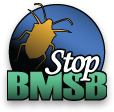Keeping Stink Bugs Out of Your House, and Your Island Nation
 |
|
New Zealand topographic image. NASA. |
Ports of entry in New Zealand are working hard to keep out brown marmorated stink bug (BMSB), relying in part on information and resources provided by the Northeastern IPM Center for identification and control.
Officials from the island nation requested, in April, about twenty odd dead insect specimens preserved in bottles of hand sanitizer. Part of the “BMSB identification kit,” these specimens are available for free through the StopBMSB.org website. See http://stopbmsb.org/go/kits
The Northeastern IPM Center provides information to visitors every day about excluding stink bugs from ordinary houses. Now we are defending the landing grounds, beaches, and farms of distant countries. In this article, we’ll discuss keeping stink bugs out of your house, and your island nation.
Home Invasion
“Brown marmorated stink bugs are rude guests, as they eat your garden and then move in with you,” said William Quarles, an IPM specialist and managing editor of the IPM Practitioner.1
If your house is invaded by 25,000 Halyomorpha halys, as has happened2, this group of bugs could produce a summer population of almost three million in the immediate vicinity of your home3 4.
“The best approach is exclusion,” Quarles said. “Pay special attention to the side of the house facing the sunset. Caulk up all holes, and make sure that window screens fit tightly. Pay attention to sealing around window air conditioners. Cover attic and foundation vents with screens. Make sure the chimney is protected with a screen. Weather-strip doors, and make sure each one has a functional door sweep.”
 |
|
Laura Nixon and Tracy Leskey in front of a robot that simulates the effect of overseas shipping on the brown marmorated stink bug. Photo by David Teulon. |
High Level Exclusion
In a video frequently promoted by the Northeastern IPM Center and StopBMSB.org, Mike Raupp of the University of Maryland Extension recommends a similar strategy. Check weather stripping around screens, windows, and doors. Inspect for cracks and holes, especially where utilities pass in and out, and seal them with caulk (small gaps) or foam (large ones). Stink bugs prefer attics; check screens there. Also check air conditioning units for gaps around them; cover them when not in use. To exterminate the rascals, don’t flush them, as it wastes water. A much more environmentally sound way is to put them in a reusable plastic food storage container and toss them in the freezer for a couple of days. “That will chill them out,” says Raupp. Dead stink bugs can be emptied outdoors or onto your compost pile. See http://stopbmsb.org/go/thLr
We Shall Defend Our Island, Whatever the Cost May Be
New Zealand attracts worldwide fame for its high value, low pesticide fruit and vegetable industry. BMSB poses a significant threat to the island’s economic base. David Teulon, an official in New Zealand working with an organization called Better Border Biosecurity, or B3, recently contacted the Northeastern IPM Center to obtain some of our ID kits to assist pre-border detection of BMSB. The bugs often stow away in cargo, freight, and packages and finding them before they arrive is a critical prevention strategy.
In work by a New Zealand researcher, Laura Nixon, a Ph.D. student at Lincoln University in Christchurch, designed a study to detect scents emitted by BMSB during overseas shipping. Her partner, Amy Tabb, who works in Tracy Leskey’s USDA lab in West Virginia, programmed a robot to simulate the movement of a package carried by a forklift and a ship on its journey. The package is designed to serve as an overwintering shelter containing BMSB. The robot, mimicking the lifting of machinery and the waves of the ocean, shifts and undulates the package. The machinery then identifies the chemistry of scents emitted by the insects. The aim is to see if such typical disturbances of the insects during shipping can be detected automatically. See https://youtu.be/h19hrwp9eUw
References
1 Quarles, W. IPM for the Brown Marmorated Stink Bug. Bio-Integral Resource Center and the Northeastern IPM Center. http://neipmc.org/go/DpPF Accessed May 19, 2017.
2 Inkley, D.B. 2012. Characteristics of home invasion by the brown marmorated stink bug. J. Entomol. Sci. 47(2):125–130.
3 Lee, D-H., B.D. Short, S.V. Joseph, et al. 2013. Review of the biology, ecology, and management of Halyomorpha halys in China, Japan, and the Republic of Korea. Environ Entomol. 42(4):627–641.
4 Kawada, H. and C. Kitamura. 1983. The reproductive behavior of the brown marmorated stink bug, Halyomorpha mista. Appl. Ent. Zool. 18(2):234–242.
